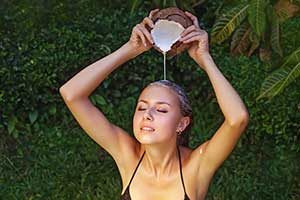If you’ve spent any time researching the best methods to keep your natural hair not only clean, but soft, supple and frizz free, you’ve bound to have come across the term “co-washing” as a preferred washing method for natural hair. Just what is co-washing? Co-washing is short for conditioner washing: using conditioner to cleanse and moisturize your hair in place of shampoo.
 Many advocates of co-washing feel that shampooing, even sulfate-free shampoos*, can cause natural hair to become dry and frizzy. That’s because natural hair is more porous. As we all know, when hair is consistently dry, it’s prone to breakage; and who wants frizzy, flyaway, broken hair?
Many advocates of co-washing feel that shampooing, even sulfate-free shampoos*, can cause natural hair to become dry and frizzy. That’s because natural hair is more porous. As we all know, when hair is consistently dry, it’s prone to breakage; and who wants frizzy, flyaway, broken hair?
The bottom line is that you should do what works best for your hair and scalp. Experiment with sulfate-free shampoos. There are lots of really good ones out there that are formulated to meet the needs of natural hair.
How to Co-wash
You can either apply the conditioner directly to your scalp from your hands, or dilute your conditioner with a little water. If diluting, use a squeeze bottle, or a cup by adding your normal amount of conditioner based on your hair length to one part water. You may need to double this mixture if you are washing your hair twice. You can add more conditioner or water based on your preferences. There are lots of wonderful sulfate-free conditioners to choose from, or use your favorite.
Wet your hair first by rinsing well; just as you would if you were about to shampoo. Apply the conditioner mixture to the scalp and gently rub your scalp clean using your fingertips. Gently pull the conditioner mixture from roots to the ends.
You’ll have to experiment with your co-washing routine in order to determine whether or not to directly apply conditioner works better than diluting it, or vice-versa.
*A Few Words About Sulfates in Shampoos: There’s a lot of buzz about sulfate versus sulfate free shampoos. But what just is sulfate and why should we avoid it in shampoos? Sulfate, also known as SLS- Sodium Lauryl Sulfate, is a chemical detergent that is not only found in shampoos, but in your dish washing liquid, laundry detergent, bathroom cleaner, garage cleaners, or any other non-natural product that is used to clean a surface. ALS, also known as Ammonium Lauryl Sulfate, is another type of sulfate to avoid that is frequently found in shampoos. Ammonium? Hmmmm…
Sulfates are very inexpensive for manufacturers to use. It’s the sulfate that creates all that lather that we are used to in shampoos. Think about all of the shampoo commercials and ads that you ever seen. In the advertisement, there’s a woman with long, straight hair with mounds of white foam and bubbles.
Consumers have come to equate all that lathers with perfect, squeaky clean hair, but you don’t want your hair to be squeaky clean because that means that your hair has been stripped of not only dirt but the natural oils needed to keep your hair protected. You do want your hair to be clean and moisturized.
Many believe that there is a direct correlation between thinning hair and scalp problems such as dandruff and shampoos with sulfates. In terms of dandruff, which is caused by a fungus, sulfates strip the scalp of healthy bacteria making the scalp more susceptible to the fungus that causes dandruff. The chemicals are also thought to damage the root of the hair, which can cause thinning hair.